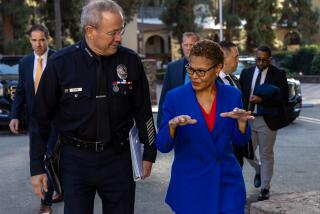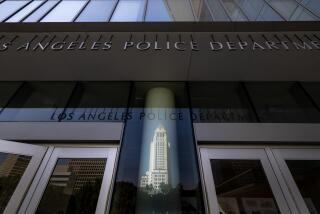LAPD far short of funds for DNA tests
The Los Angeles Police Department would need $9.3 million to clear up a backlog of untested DNA evidence that could hold the key to solving hundreds of sexual assaults and other violent crimes, but state and local money is falling far short of covering the cost, officials say.
The problem was underscored by a state audit released Thursday that detailed the shortfall that has existed between state aid and local law enforcement needs.
Under Proposition 69, approved by voters in 2004 to expand California’s DNA database, a special court fee was established to pay for DNA collection and analysis. Initially, most of the fee money went to the state crime lab, which was able to slash its own backlog of untested evidence.
The LAPD has received only $530,000 from the court fee over the last three years for DNA collection from felons, and nothing to analyze crime scene evidence, authorities said. The department expects to receive $1 million in state money next year for its crime lab, but officials say that will barely begin to close the gap.
Evidence from 6,700 LAPD sexual assault cases is stored in envelopes and cartons inside cold storage lockers and trailers at a city warehouse facility on the eastern fringe of downtown and in a trailer behind police headquarters. Each packet is a potential genetic road map to a rapist or killer, whose capture and conviction could bring some peace of mind to survivors and their families.
In some cases, police say, the rapist has confessed, or immediate analysis is not necessary for other reasons. But despite the launch of a new regional L.A. crime laboratory last summer and public expectations of “CSI”-style efficiency, packages have been sitting untested for up to a decade, LAPD officials acknowledged.
The logjam is particularly frustrating because the department has found that 37% of cases with DNA evidence produce a “hit,” or match, when tested against the FBI’s national DNA databank. And while the LAPD says it is keeping up with 30 new DNA evidence packets arriving each week, Chief William J. Bratton said the backlog may never be cleared without additional funding.
“Passion is not money, and this situation takes money we don’t have,” Bratton said in an interview Wednesday. “It is not for lack of desire. I had a [relative] who was very viciously raped, and I dealt with that firsthand when she was 14 years old.
“Thirty years later she is still dealing with the trauma of that rape,” he said. “So there is nothing I am more aware of personally and intimately in terms of damages caused by these things.”
The problem is not unique to Los Angeles. Forensic DNA testing facilities nationwide have been swamped by demands, not only from regular investigators but also from “cold hit” squads seeking breaks in long-dormant cases and from convicts with innocence claims. According to U.S. Justice Department statistics, more than 500,000 unsolved crimes, including 169,000 rapes, have DNA evidence that has gone untested.
In Los Angeles County, the backlog has occasionally caused trial dates to be canceled, frustrated detectives and delayed justice for victims and their families. More seriously, an evidence kit that went untested for months left a rapist free to assault another woman and a teenager.
Detective Tim Marcia said he knew when he arrived at the scene of a February 2000 sexual assault on a 43-year-old legal secretary in Mid-Wilshire that it was the work of a serial rapist. So when he was told DNA analysis at the LAPD facility would take eight months, the detective drove the victim’s evidence swab to the state crime lab.
Four months later, Christopher Cardwell broke into a pregnant woman’s home in Los Angeles and sexually assaulted her. The next month he raped a 17-year-old girl, also in her home. After the DNA testing was completed in August, Cardwell was convicted of 20 sex crimes against the three Los Angeles victims and one other and sentenced to 580 years to life in prison.
“It is unconscionable that victims should have to endure sexual assaults and other acts of brutality while the evidence that prevents these crimes sits untested,” said Councilman Jack Weiss, who raised the case in a recent letter to his colleagues on the issue.
LAPD Cmdr. Harlan Ward said some of the stockpiled evidence is from closed cases; in others, police already know who the rapist is or don’t believe there was a crime. Individual detectives prioritize testing in cases in which it could be the most helpful, such as rapes by strangers.
But odds are that among the 6,700 rape kits are genetic guideposts to the identities of hundreds of unknown rapists, authorities said.
“Every kit in the freezer represents a woman or child who has been raped and put their faith in the system,” said Gail Abarbanel, founder of the Rape Treatment Center at Santa Monica-UCLA Medical Center.
Lisa Kahn, a deputy district attorney specializing in DNA evidence, said authorities don’t know how big the problem is because they don’t know what’s in the untested evidence kits. But Abarbanel thinks many repeat offenders could be stopped through more testing.
“We desperately need more police officers on the street, but it is just as important to put criminalists in the crime lab,” she said.
Rape charges must be filed within 10 years of the assault, but the cutoff is suspended if a DNA profile is produced within the first two years. Greg Matheson, head of the LAPD crime lab, acknowledged that not all the department’s DNA evidence in rape cases is tested within the two years limit and that some is not even analyzed before the 10-year statutory deadline.
In order to better meet the two-year deadline, the LAPD went back this year over sexual assault cases in which detectives had initially passed on DNA testing. After selecting the most promising ones, they found that 44% of the cases had DNA evidence and that 10% of those produced a hit in the national databank.
The LAPD lab has a city-financed budget of $5.7 million for DNA work, plus a $1-million grant this year. Earlier this month Weiss offered a proposal to generate the additional $9.3 million to clear the backlog.
The plan is similar to an initiative New York City used to eliminate its backlog a few years ago. But Bratton, during the interview, said the proposal is “dead on arrival” because the city doesn’t have the money.
“I guarantee when it goes before the council it is not going to go anywhere, and that is not because the council is not well intended,” Bratton said.
Assistant Chief Sharon Papa said the department is considering approaching private donors to pay to test evidence at private labs.
The California state auditor looked at how the DNA court fee is collected throughout the state, focusing on whether the revenue covered collection costs for three counties, Orange, Los Angeles and Sacramento.
Orange County law enforcement, in 2005, sought $1.4 million to cover taking samples from felons and received $314,000 from the court fee, the audit found. Los Angeles County in 2006 asked for $1.9 million and received $1.7 million. While the LAPD got $530,000, some agencies, including the Orange County district attorney’s office, did not get any financial help, the audit found.
“Because of inadequate funding, the counties we visited could reimburse the costs of only a few departments,” the audit said.
In Los Angeles, one of the temperature-controlled lockers containing the backlogged evidence is so crowded that boxes are stacked in the aisles. The evidence envelopes are lined up in neat rows as if they were drugstore photos awaiting pickup.
Steve Johnson, the LAPD administrator who oversees property facilities, opened the door to one of the trailers and shined his flashlight inside. One box was labeled, “1997. Black pants, underwear.” Another contained a blanket and a Raiders sweat shirt.
Johnson opened another trailer. The roof was caked with ice, which flaked off onto the cardboard packages below.
“If the power goes out, these things stay cold enough for long enough to get them repaired,” Johnson said. “We’re building two more freezers.”
--
patrick.mcgreevy@latimes.com
More to Read
Start your day right
Sign up for Essential California for news, features and recommendations from the L.A. Times and beyond in your inbox six days a week.
You may occasionally receive promotional content from the Los Angeles Times.








